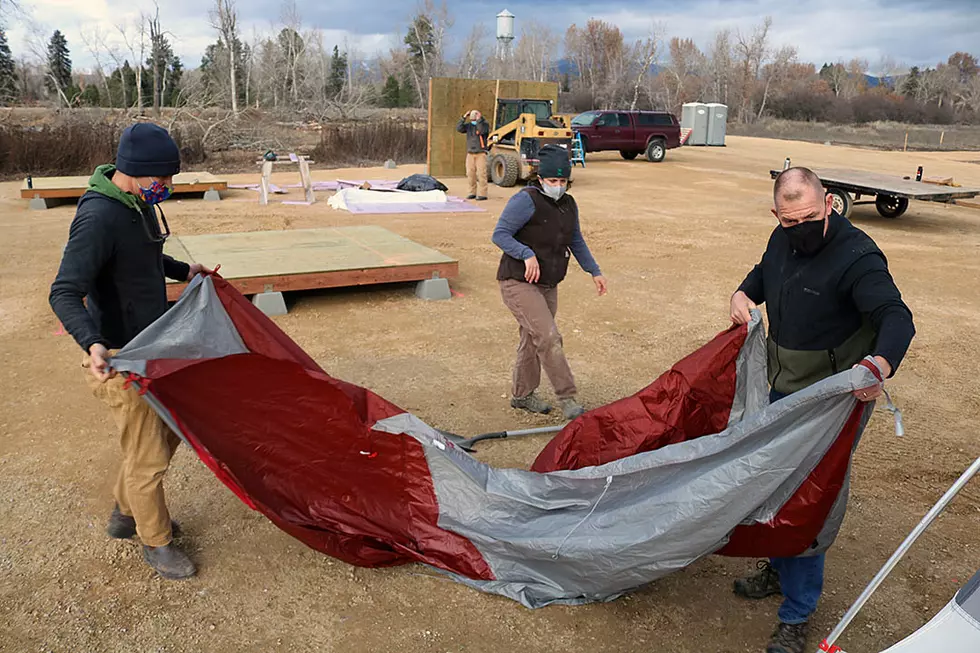
Missoula County, city honing efforts to establish sanctioned homeless camp
Citing the success of last year's outdoor shelter program, Missoula County this week announced its plans to create a “policy foundation” intended to established and fund a supported camp for the area's unhoused population.
The City of Missoula is working on similar steps to open a sanctioned campground off North Reserve Street, one intended to replace the illegal campground under the Reserve Street Bridge.
The county's resolution, introduced on Thursday, could align with those efforts.
“This resolution is a policy foundation for future action and expenditures,” said Commissioner Josh Slotnick. “We are going to endeavor to provide some type of sanctioned shelter for anyone living outdoors in an unsanctioned space.”
The county's resolution and the city's actions are among a number of moving parts directed toward Missoula's unhoused population. Among them, the Montana Department of Transportation – under pressure from the Missoula City-County Health Department – fenced off the illegal Reserve Street homeless camp last month.
It was the first step in trying to rid the area of illegal campers and the garbage and hazardous waste that comes with it. But the camping will be permitted to continue, illegal or not, until the city and county establish a sanctioned camp on city property located nearby.
“Once that's accomplished, we will actively enforce to the best we can through existing laws in terms of where a person can and can't be,” said Slotnick. “There will always be people living where they're not supposed to be. But we'll see that environmental blight go away because, once we create an alternative, we've made space for ourselves to do some real enforcement.”
Missoula Mayor John Engen touched on the same subject earlier in the week, saying the city was talking with the Montana Department of Transportation “on how things will shake out at Reserve Street when we can provide an alternative camp site.”
The county's resolution notes the factors that lead to homelessness, including addiction, mental illness and poverty. It also notes one's inability to pay medical costs, the loss of a job and other life circumstances.
Whatever the cause, both the city and county are taking intentional action to provide support and the services one needs to alter their course in life. The costs of running a sanctioned camp and providing the services haven't been disclosed.
“This is that foundational piece as we continue to move forward and look to address our unhoused population, both for the folks who we think of as being traditionally unhoused, but also for those with the market who are going through housing difficulties,” said county CAO Chris Lounsbury. “There's going to be surety and commitment behind what we do.”
Last winter, community partners opened a legal camp on the south side of Missoula, offering a tent shelter in a secured environment. The Temporary Safe Outdoor Space had the capacity to accommodate around 40 individuals over the course of the winter.
The facility, estimated at around $100,000, was designed to house those who are reluctant to enter Missoula's other shelters. Homeless advocates have said that's the type of population that often resides under the Reserve Street bridge.
“Last year, we took some bold action to get our unhoused population into a safe, sanitary and secure environment,” Slotnick said. “Since then, we've learned accidentally, when unhoused folks are in a sanctioned shelter, thy actually move their lives forward.”
Slotnick said many of those who sought shelter at the outdoor space worked to make some changes. Some obtained identification and some got jobs. The arrangement also cut down on environmental blight by concentrating garbage and providing sanitation facilities.
“Having unhoused folks living in a sanctioned, controlled environment is good for the environment and good for the people involved,” Slotnick said. “So we're contemplating taking some big steps in how we work with our unhoused population.”
In July, and in effort to address homelessness and its many forms, the city and county unveiled a plan they dubbed Operation Shelter. An incident team assigned to the task recommended three separate sites across the city to accommodate legal camping, temporary shelter and transitional housing.
The Sleepy Inn was recommended as transitional housing for the time being while the city's compost facility, located behind the Super Walmart off Reserve, was identified as the preferred location for the sanctioned camping site.
And while critics fear that providing an array of services for the unhoused will only attract more people in need to Missoula, the county continues to argue otherwise. The "build-it-and-they-will-come" mantra is less concerning than helping those who are in need today, they said.
“We have an unhoused population right now in our midst, and we need to take action to address that concern,” said Commissioner Dave Strohmaier. “What we've seen in our safe outdoor shelter was that the vast majority of those using that service were folks who have lived in Missoula for some period of time. They're not drifting there to avail themselves to those services.
“I'm of the mind that we ought not be paralyzed and concerned over what might happen in the future and not address the needs we have right now.”
